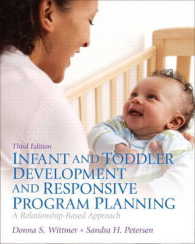- ホーム
- > 洋書
- > 英文書
- > History / World
Full Description
Sticks, Stones, and Broken Bones: Neolithic Violence in a European Perspective presents an up-to-date overview of the evidence for violent injuries on human skeletons of the Neolithic period in Europe, ranging from 6700 to 2000 BC. Unlike other lines of evidence - weapons, fortifications, and imagery - the human skeleton preserves the actual marks of past violent encounters.
The papers in this volume are written by the experts undertaking the archaeological analysis, and present evidence from eleven European countries which provide, for the first time, the basis for a comparative approach between different regions and periods. Difficulties and ambiguities in interpreting the evidence are also discussed, although many of the cases are clearly the outcome of conflict. Injuries often show healing, but others can be seen as the cause of death. In many parts of Europe, women and children appear to have been the victims of violence as often as adult men.
The volume not only presents an excellent starting point for a new consideration of the prevalence and significance of violence in Neolithic Europe, but provides an invaluable baseline for comparisons with both earlier and later periods.
Contents
1. Skeletal evidence for interpersonal violence in Neolithic Europe: an introduction ; 2. The placement of the Feathers: Violence among Sub-boreal foragers from Gotland, central Baltic Sea ; 3. Violence in the Stone Age from an Eastern Baltic perspective ; 4. Skeletal trauma and violence among the early farmers of the North European Plain: Evidence from Neolithic settlements of the Lengyel Culture in Kuyavia, North-Central Poland ; 5. The Neolithic massacre at Talheim - A pivotal find in conflict archaeology ; 6. The early Neolithic site Asparn/Schletz (Lower Austria): Anthropological evidence of interpersonal violence ; 7. Violence against the living, violence against the dead: Evidence of a crisis and mass cannibalism on the human remains from Herxheim, Germany ; 8. Violence in the Single Grave Culture of Northern Germany ; 9. Injured but special: On associations between skull defects and burial treatment in the Corded Ware Culture of Central Germany ; 10. Investigating cranial trauma in the German Wartberg Culture ; 11. Interpersonal violence in the Late Mesolithic and Middle Neolithic in the Netherlands ; 12. Neolithic violence in France: an overview ; 13. Skeletal evidence for interpersonal violence: beyond mortuary monuments in southern Britain ; 14. Evidence of trauma in Neolithic Greece ; 15. Prehistoric violence in Northern Spain: San Juan ante Portam Latinam ; 16. Evidence of traumatic skeletal injuries in the collective burial caves of the Nabao Valley, Central Portugal ; 17. Skeletal evidence of interpersonal violence from Portuguese Late Neolithic collective burials: an overview








